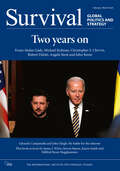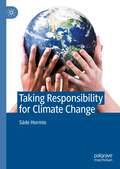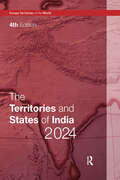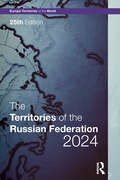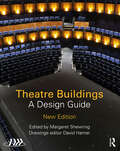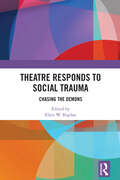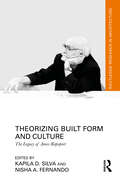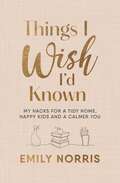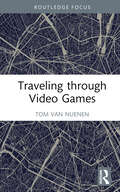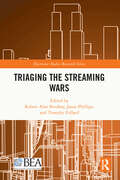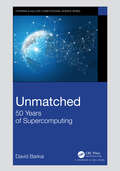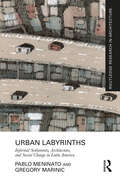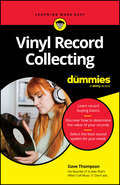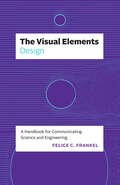- Table View
- List View
Survival: February-March 2024
Survival, the IISS’s bimonthly journal, challenges conventional wisdom and brings fresh, often controversial, perspectives on strategic issues of the moment.In this issue: Franz-Stefan Gady and Michael Kofman highlight the pitfalls of grafting a Western manoeuvre-oriented approach to war onto the Russia–Ukraine conflict Irene Mia examines the chasm between Javier Milei’s dramatic rhetoric and the domestic and international obstacles he faces to changing Argentina’s foreign and economic policies Edoardo Campanella and John Haigh outline the necessity of meaningful dialogue between the West and China to prevent the internet’s fragmentation John Raine assesses the geopolitical trends that the Gaza war has set in motion and the issues they create for Ukraine’s defence against Russia And seven more thought-provoking pieces, as well as our regular Book Reviews and Noteworthy column. Editor: Dr Dana AllinManaging Editor: Jonathan StevensonAssociate Editor: Carolyn WestEditorial Assistant: Conor Hodges
Survival: February-March 2024
Survival, the IISS’s bimonthly journal, challenges conventional wisdom and brings fresh, often controversial, perspectives on strategic issues of the moment.In this issue: Franz-Stefan Gady and Michael Kofman highlight the pitfalls of grafting a Western manoeuvre-oriented approach to war onto the Russia–Ukraine conflict Irene Mia examines the chasm between Javier Milei’s dramatic rhetoric and the domestic and international obstacles he faces to changing Argentina’s foreign and economic policies Edoardo Campanella and John Haigh outline the necessity of meaningful dialogue between the West and China to prevent the internet’s fragmentation John Raine assesses the geopolitical trends that the Gaza war has set in motion and the issues they create for Ukraine’s defence against Russia And seven more thought-provoking pieces, as well as our regular Book Reviews and Noteworthy column. Editor: Dr Dana AllinManaging Editor: Jonathan StevensonAssociate Editor: Carolyn WestEditorial Assistant: Conor Hodges
Taking Responsibility for Climate Change
by Säde HormioThis book proposes that it is not only states and international bodies that have a responsibility to take action toward mitigating climate change. Other collective agents, such as corporations, need to also come onboard. Additionally, the book argues that climate change is not solely a problem for collective agents, but also for individuals, as they are members of collectives and groups of several kinds. Therefore, framing climate change responsibility exclusively from either the collective or the individual perspective leaves out something crucial: how we all are influenced by the collectives we belong to and how, in turn, collectives are influenced by individuals. The focus of the book is on areas of climate change responsibility that are often left out of the picture or get too little attention in climate ethics, such as carbon inequality within countries. But why should any theoretical arguments about normative issues matter when we have a real-life climate crisis on our hands? Säde Hormio argues that ethical arguments have an important role in setting climate policy: they can highlight what values are at stake and help ground normative arguments in public deliberations.
The Territories and States of India 2024 (Europa Territories of the World series)
This invaluable collection of information provides an in-depth guide to the regional dimension of the politics and economy of this vast and complex country. Incomparable in its coverage, which includes a detailed chronology for India as a whole, a bibliography, contact details for leading officials, and an historical account and economic survey for each of the twenty-nine states and seven territories, it supplies the reader with a more complete understanding of India as a whole.
The Territories and States of India 2024 (Europa Territories of the World series)
by Meena KhanThis invaluable collection of information provides an in-depth guide to the regional dimension of the politics and economy of this vast and complex country. Incomparable in its coverage, which includes a detailed chronology for India as a whole, a bibliography, contact details for leading officials, and an historical account and economic survey for each of the twenty-nine states and seven territories, it supplies the reader with a more complete understanding of India as a whole.
The Territories of the Russian Federation 2024 (Europa Territories of the World series)
This excellent reference source brings together hard-to-find information on the constituent units of the Russian Federation.The introduction examines the Russian Federation as a whole, followed by a chronology, demographic and economic statistics, and a review of the Federal Government. The second section comprises territorial surveys, each of which includes a current map. This edition includes surveys covering the annexed (and disputed) territories of Crimea and Sevastopol, as well as updated surveys of each of the other 83 federal subjects. The third section comprises a select bibliography of books. The fourth section features a series of indexes, listing the territories alphabetically, by Federal Okrug and Economic Area. Users will also find a gazetteer of selected alternative and historic names, a list of the territories abolished, created or reconstituted in the post-Soviet period, and an index of more than 100 principal cities, detailing the territory in which each is located.
The Territories of the Russian Federation 2024 (Europa Territories of the World series)
This excellent reference source brings together hard-to-find information on the constituent units of the Russian Federation.The introduction examines the Russian Federation as a whole, followed by a chronology, demographic and economic statistics, and a review of the Federal Government. The second section comprises territorial surveys, each of which includes a current map. This edition includes surveys covering the annexed (and disputed) territories of Crimea and Sevastopol, as well as updated surveys of each of the other 83 federal subjects. The third section comprises a select bibliography of books. The fourth section features a series of indexes, listing the territories alphabetically, by Federal Okrug and Economic Area. Users will also find a gazetteer of selected alternative and historic names, a list of the territories abolished, created or reconstituted in the post-Soviet period, and an index of more than 100 principal cities, detailing the territory in which each is located.
Theatre Buildings: A Design Guide
by Association of British Theatre Technicians (ABTT) Margaret ShewringIn 2021, its Diamond Jubilee year, the Association of British Theatre Technicians (ABTT) undertook to revise Theatre Buildings: A Design Guide (Routledge, 2010). This new edition (Routledge, 2023) has substantially re-written text with fresh images and entirely new reference projects, providing essential guidance for all those engaged in the design of theatre buildings. Edited by Margaret Shewring (Emeritus Reader, University of Warwick, former Director of the Postgraduate Diploma and MA in Theatre Consultancy), this new publication is written by a team of international experts, architects, theatre consultants, acousticians, engineers and industry professionals led by Tim Foster (Foster Wilson Size) and Robin Townley (CEO of the ABTT). It provides an invaluable resource for those looking to build, remodel or conserve theatre buildings, taking into account the significant changes which have taken place in the last twelve years in all aspects of theatre design and technical practice. It locates those changes in the wider context of the need for sustainability in the theatre industry in response to the climate emergency, inclusivity, diversity of access, placemaking and concerns for health and wellbeing. This new edition provides guidance for anyone who seeks inspiration and encouragement to create or improve a place of entertainment or who seeks to understand what might be required to accommodate an audience for the presentation of live performance and the successful use, operation and organisation of such a venue. Its generous format and the thirty-two new reference projects, more than 260 high-resolution colour images and 175 diagrams and specially commissioned plans make it accessible and informative both to the general reader and the professional specialist.
Theatre Buildings: A Design Guide
by Margaret Shewring David HamerIn 2021, its Diamond Jubilee year, the Association of British Theatre Technicians (ABTT) undertook to revise Theatre Buildings: A Design Guide (Routledge, 2010). This new edition (Routledge, 2023) has substantially re-written text with fresh images and entirely new reference projects, providing essential guidance for all those engaged in the design of theatre buildings. Edited by Margaret Shewring (Emeritus Reader, University of Warwick, former Director of the Postgraduate Diploma and MA in Theatre Consultancy), this new publication is written by a team of international experts, architects, theatre consultants, acousticians, engineers and industry professionals led by Tim Foster (Foster Wilson Size) and Robin Townley (CEO of the ABTT). It provides an invaluable resource for those looking to build, remodel or conserve theatre buildings, taking into account the significant changes which have taken place in the last twelve years in all aspects of theatre design and technical practice. It locates those changes in the wider context of the need for sustainability in the theatre industry in response to the climate emergency, inclusivity, diversity of access, placemaking and concerns for health and wellbeing. This new edition provides guidance for anyone who seeks inspiration and encouragement to create or improve a place of entertainment or who seeks to understand what might be required to accommodate an audience for the presentation of live performance and the successful use, operation and organisation of such a venue. Its generous format and the thirty-two new reference projects, more than 260 high-resolution colour images and 175 diagrams and specially commissioned plans make it accessible and informative both to the general reader and the professional specialist.
Theatre Responds to Social Trauma: Chasing the Demons (Routledge Series in Equity, Diversity, and Inclusion in Theatre and Performance)
This book is a collection of chapters by playwrights, directors, devisers, scholars, and educators whose praxis involves representing, theorizing, and performing social trauma.Chapters explore how psychic catastrophes and ruptures are often embedded in social systems of oppression and forged in zones of conflict within and across national borders. Through multiple lenses and diverse approaches, the authors examine the connections between collective trauma, social identity, and personal struggle. We look at the generational transmission of trauma, socially induced pathologies, and societal re-inscriptions of trauma, from mass incarceration to war-induced psychoses, from gendered violence through racist practices. Collective trauma may shape, protect, and preserve group identity, promoting a sense of cohesion and meaning, even as it shakes individuals through pain. Engaging with communities under significant stress through artistic practice offers a path towards reconstructing the meaning(s) of social trauma, making sense of the past, understanding the present, and re-visioning the future.The chapters combine theoretical and practical work, exploring the conceptual foundations and the artists’ processes as they interrogate the intersections of personal grief and communal mourning, through drama, poetry, and embodied performance.
Theatre Responds to Social Trauma: Chasing the Demons (Routledge Series in Equity, Diversity, and Inclusion in Theatre and Performance)
by Ellen W. KaplanThis book is a collection of chapters by playwrights, directors, devisers, scholars, and educators whose praxis involves representing, theorizing, and performing social trauma.Chapters explore how psychic catastrophes and ruptures are often embedded in social systems of oppression and forged in zones of conflict within and across national borders. Through multiple lenses and diverse approaches, the authors examine the connections between collective trauma, social identity, and personal struggle. We look at the generational transmission of trauma, socially induced pathologies, and societal re-inscriptions of trauma, from mass incarceration to war-induced psychoses, from gendered violence through racist practices. Collective trauma may shape, protect, and preserve group identity, promoting a sense of cohesion and meaning, even as it shakes individuals through pain. Engaging with communities under significant stress through artistic practice offers a path towards reconstructing the meaning(s) of social trauma, making sense of the past, understanding the present, and re-visioning the future.The chapters combine theoretical and practical work, exploring the conceptual foundations and the artists’ processes as they interrogate the intersections of personal grief and communal mourning, through drama, poetry, and embodied performance.
Theorizing Built Form and Culture: The Legacy of Amos Rapoport (Routledge Research in Architecture)
by Kapila D. Silva Nisha A. FernandoIn this collection of essays, Theorizing Built Form and Culture: The Legacy of Amos Rapoport – a felicitation volume to celebrate the significance of Professor Amos Rapoport's lifelong scholarship – scholars from around the world discuss the analytical relevance, expansion, and continuing application of these contributions in developing an advanced understanding of mutual relationships between people and built environments across cultures.Professor Amos Rapoport has espoused an intellectual and theoretical legacy on environmental design scholarship that explains how cultural factors play a significant role in the ways people create and use environments as well as the way environments, in turn, influence people’s behavior. This volume presents a hitherto-not-seen, unique, and singular work that simultaneously articulates a cohesive framework of Rapoport’s architectural theories and demonstrates how that theoretical approach be used in architectural inquiry, education, and practice across environmental scales, types, and cultural contexts. It also acknowledges, for the very first time, how this theoretical legacy has pioneered the decolonizing of the Eurocentric approaches to architectural inquiry and has thus privileged an inclusive, cross-cultural perspective that laid the groundwork to understand and analyze non-Western design traditions. The book thus reflects a wide range of cross-cultural and cross-contextual range to which Professor Rapoport’s theories apply, a general notion of theoretical validity he always advocated for in his own writings.The volume is a paramount source for scholars and students of architecture who are interested in understanding how culture mediates the creation, use, and preservation of the built environment.
Theorizing Built Form and Culture: The Legacy of Amos Rapoport (Routledge Research in Architecture)
In this collection of essays, Theorizing Built Form and Culture: The Legacy of Amos Rapoport – a felicitation volume to celebrate the significance of Professor Amos Rapoport's lifelong scholarship – scholars from around the world discuss the analytical relevance, expansion, and continuing application of these contributions in developing an advanced understanding of mutual relationships between people and built environments across cultures.Professor Amos Rapoport has espoused an intellectual and theoretical legacy on environmental design scholarship that explains how cultural factors play a significant role in the ways people create and use environments as well as the way environments, in turn, influence people’s behavior. This volume presents a hitherto-not-seen, unique, and singular work that simultaneously articulates a cohesive framework of Rapoport’s architectural theories and demonstrates how that theoretical approach be used in architectural inquiry, education, and practice across environmental scales, types, and cultural contexts. It also acknowledges, for the very first time, how this theoretical legacy has pioneered the decolonizing of the Eurocentric approaches to architectural inquiry and has thus privileged an inclusive, cross-cultural perspective that laid the groundwork to understand and analyze non-Western design traditions. The book thus reflects a wide range of cross-cultural and cross-contextual range to which Professor Rapoport’s theories apply, a general notion of theoretical validity he always advocated for in his own writings.The volume is a paramount source for scholars and students of architecture who are interested in understanding how culture mediates the creation, use, and preservation of the built environment.
Things I Wish I’d Known: My hacks for a tidy home, happy kids and a calmer you
by Emily Norris'Queen of the mothering hack. Emily Norris delivers ingenious ideas to make life a little bit easier!’ – Giovanna Fletcher, bestselling author and podcaster'Genius hacks to save time and bring a little more joy' – Anna Mathur, Psychotherapist and bestselling author'Packed with tips and ideas that make mum life *just* a little easier!' – Harriet Shearsmith, @tobyandrooI became obsessed with mum hacks when a friend showed me a game-changing tip during my baby days - that baby vests can be pulled down (not up) in the event of an explosive poo. I couldn't believe I had been a mum for so long and not known! Things I Wish I'd Known will bring you hundreds of quick and clever solutions, just like this, all to make the parenting juggle easier.You'll find my favourite hacks and habits, as well as dozens of new ones, all designed to give your day-to-day a lift. From cleaning hacks that leave your home sparkling in no time, laundry tricks that save you money, and simple tweaks to night-time routines which transform everyone's sleep, I'll show you how to hack every aspect of home-life so you feel less stress and more joy!Emily x
Traveling through Video Games (Routledge Advances in Game Studies)
by Tom van NuenenThis book unlocks an understanding of video games as virtual travel. It explains how video game design increasingly takes cues from the promotional language of tourism, and how this connection raises issues of power and commodification. Bridging the disciplinary gap between game and tourism studies, the book offers a comprehensive account of touristic gazing in games such as The Legend of Zelda: Breath of the Wild, Minecraft, and Microsoft Flight Simulator 2020. Traveling through video games involves a mythological promise of open-ended opportunity, summarized in the slogan you can go there. Van Nuenen discusses the scale of game worlds, the elusive nature of freedom and control, and the pivotal role of work in creating a sense of belonging. The logic of tourism is fundamentally consumptive—but through design choices, players can also be invited to approach their travels more critically. This is the difference between moving through a game world, and being moved by it. This interdisciplinary and innovative study will interest students and scholars of digital media studies, game studies, tourism and technology, and the Digital Humanities.
Traveling through Video Games (Routledge Advances in Game Studies)
by Tom van NuenenThis book unlocks an understanding of video games as virtual travel. It explains how video game design increasingly takes cues from the promotional language of tourism, and how this connection raises issues of power and commodification. Bridging the disciplinary gap between game and tourism studies, the book offers a comprehensive account of touristic gazing in games such as The Legend of Zelda: Breath of the Wild, Minecraft, and Microsoft Flight Simulator 2020. Traveling through video games involves a mythological promise of open-ended opportunity, summarized in the slogan you can go there. Van Nuenen discusses the scale of game worlds, the elusive nature of freedom and control, and the pivotal role of work in creating a sense of belonging. The logic of tourism is fundamentally consumptive—but through design choices, players can also be invited to approach their travels more critically. This is the difference between moving through a game world, and being moved by it. This interdisciplinary and innovative study will interest students and scholars of digital media studies, game studies, tourism and technology, and the Digital Humanities.
Triaging the Streaming Wars (ISSN)
This volume considers the different implications of the rise of streaming services and their particular acceleration during the COVID-19 pandemic. Exploring the significant disruption caused to the entertainment industries by the rise of these streaming services, a team of international scholars examine changes to labor issues and compensation, which were central to the conflict between the Writers Guild of America members and their agents, the broadening divide between networks and affiliates, the significant consolidation of the media industry resulting from Disney’s acquisition of Fox ahead of the launch of Disney+, and the variety of business models behind these services that defy the traditional advertising models and standard revenue streams. This thorough and multifaceted look at this rapidly growing section of the entertainment industry will be of interest to academics and students working in film and TV studies, media industry studies, digital media studies, business, and communication studies.
Triaging the Streaming Wars (ISSN)
by Robert Alan Brookey Jason Phillips Timothy PollardThis volume considers the different implications of the rise of streaming services and their particular acceleration during the COVID-19 pandemic. Exploring the significant disruption caused to the entertainment industries by the rise of these streaming services, a team of international scholars examine changes to labor issues and compensation, which were central to the conflict between the Writers Guild of America members and their agents, the broadening divide between networks and affiliates, the significant consolidation of the media industry resulting from Disney’s acquisition of Fox ahead of the launch of Disney+, and the variety of business models behind these services that defy the traditional advertising models and standard revenue streams. This thorough and multifaceted look at this rapidly growing section of the entertainment industry will be of interest to academics and students working in film and TV studies, media industry studies, digital media studies, business, and communication studies.
Unmatched: 50 Years of Supercomputing (Chapman & Hall/CRC Computational Science)
by David BarkaiUnmatched: 50 Years of Supercomputing: A Personal Journey Accompanying the Evolution of a Powerful ToolThe rapid and extraordinary progress of supercomputing over the past half-century is a powerful demonstration of our relentless drive to understand and shape the world around us. In this book, David Barkai offers a unique and compelling account of this remarkable technological journey, drawing from his own rich experiences working at the forefront of high-performance computing (HPC).This book is a journey delineated as five decade-long ‘epochs’ defined by the systems’ architectural themes: vector processors, multi-processors, microprocessors, clusters, and accelerators and cloud computing. The final part examines key issues of HPC and discusses where it might be headed.A central goal of this book is to show how computing power has been applied, and, more importantly, how it has impacted and benefitted society. To this end, the use of HPC is illustrated in a range of industries and applications, from weather and climate modeling to engineering and life sciences. As such, this book appeals to both students and general readers with an interest in HPC, as well as industry professionals looking to revolutionize their practice.From the Foreword:“David Barkai's career has spanned five decades, during which he has had the rare opportunity to be part of some of the most significant developments in the field of supercomputing. His personal and professional insights, combined with his deep knowledge and passion for the subject matter, make this book an invaluable resource for anyone interested in the evolution of HPC and its impact on our lives.”-Horst Simon, Director, Abu Dhabi Investment Authority (ADIA) Lab
Unmatched: 50 Years of Supercomputing (Chapman & Hall/CRC Computational Science)
by David BarkaiUnmatched: 50 Years of Supercomputing: A Personal Journey Accompanying the Evolution of a Powerful ToolThe rapid and extraordinary progress of supercomputing over the past half-century is a powerful demonstration of our relentless drive to understand and shape the world around us. In this book, David Barkai offers a unique and compelling account of this remarkable technological journey, drawing from his own rich experiences working at the forefront of high-performance computing (HPC).This book is a journey delineated as five decade-long ‘epochs’ defined by the systems’ architectural themes: vector processors, multi-processors, microprocessors, clusters, and accelerators and cloud computing. The final part examines key issues of HPC and discusses where it might be headed.A central goal of this book is to show how computing power has been applied, and, more importantly, how it has impacted and benefitted society. To this end, the use of HPC is illustrated in a range of industries and applications, from weather and climate modeling to engineering and life sciences. As such, this book appeals to both students and general readers with an interest in HPC, as well as industry professionals looking to revolutionize their practice.From the Foreword:“David Barkai's career has spanned five decades, during which he has had the rare opportunity to be part of some of the most significant developments in the field of supercomputing. His personal and professional insights, combined with his deep knowledge and passion for the subject matter, make this book an invaluable resource for anyone interested in the evolution of HPC and its impact on our lives.”-Horst Simon, Director, Abu Dhabi Investment Authority (ADIA) Lab
Urban Labyrinths: Informal Settlements, Architecture, and Social Change in Latin America (Routledge Research in Architecture)
by Pablo Meninato Gregory MarinicUrban Labyrinths: Informal Settlements, Architecture, and Social Change in Latin America examines intervention initiatives in informal settlements in Latin American cities as social, spatial, architectural, and cultural processes. From the mid-20th century to the present, Latin America and other regions in the Global South have experienced a remarkable demographic trend, with millions of people moving from rural areas to cities in search of work, healthcare, and education. Without other options, these migrants have created self-built settlements mostly located on the periphery of large metropolitan areas. While the initial reaction of governments was to eliminate these communities, since the 1990s, several Latin American cities began to advance new urban intervention approaches for improving quality of life. This book examines informal settlement interventions in five Latin American cities: Rio de Janeiro, Medellín, São Paulo, Buenos Aires, and Tijuana. It explores the Favela-Bairro Program in Rio de Janeiro during the 1990s which sought to improve living conditions and infrastructure in favelas. It investigates projects propelled by Social Urbanism in Medellín at the beginning of the 2000s, aimed at revitalizing marginalized areas by creating a public transportation network, constructing civic buildings, and creating public spaces. Furthermore, the book examines the long-term initiatives led by SEHAB in São Paulo, which simultaneously addresses favela upgrading works, water pollution remediation strategies, and environmental stewardship. It discusses current intervention initiatives being developed in informal settlements in Buenos Aires and Tijuana, exploring the urban design strategies that address complex challenges faced by these communities. Taken together, the Latin American architects, planners, landscape architects, researchers, and stakeholders involved in these projects confirm that urbanism, architecture, and landscape design can produce positive urban and social transformations for the most underprivileged.This book will be of interest to students, researchers, and professionals in planning, urbanism, architecture, urban design, landscape architecture, urban geography, public policy, as well as other spatial design disciplines.
Urban Labyrinths: Informal Settlements, Architecture, and Social Change in Latin America (Routledge Research in Architecture)
by Pablo Meninato Gregory MarinicUrban Labyrinths: Informal Settlements, Architecture, and Social Change in Latin America examines intervention initiatives in informal settlements in Latin American cities as social, spatial, architectural, and cultural processes. From the mid-20th century to the present, Latin America and other regions in the Global South have experienced a remarkable demographic trend, with millions of people moving from rural areas to cities in search of work, healthcare, and education. Without other options, these migrants have created self-built settlements mostly located on the periphery of large metropolitan areas. While the initial reaction of governments was to eliminate these communities, since the 1990s, several Latin American cities began to advance new urban intervention approaches for improving quality of life. This book examines informal settlement interventions in five Latin American cities: Rio de Janeiro, Medellín, São Paulo, Buenos Aires, and Tijuana. It explores the Favela-Bairro Program in Rio de Janeiro during the 1990s which sought to improve living conditions and infrastructure in favelas. It investigates projects propelled by Social Urbanism in Medellín at the beginning of the 2000s, aimed at revitalizing marginalized areas by creating a public transportation network, constructing civic buildings, and creating public spaces. Furthermore, the book examines the long-term initiatives led by SEHAB in São Paulo, which simultaneously addresses favela upgrading works, water pollution remediation strategies, and environmental stewardship. It discusses current intervention initiatives being developed in informal settlements in Buenos Aires and Tijuana, exploring the urban design strategies that address complex challenges faced by these communities. Taken together, the Latin American architects, planners, landscape architects, researchers, and stakeholders involved in these projects confirm that urbanism, architecture, and landscape design can produce positive urban and social transformations for the most underprivileged.This book will be of interest to students, researchers, and professionals in planning, urbanism, architecture, urban design, landscape architecture, urban geography, public policy, as well as other spatial design disciplines.
Vinyl Record Collecting For Dummies
by Dave ThompsonGet on the vinyl train and learn about this captivating hobby Vinyl Record Collecting For Dummies teaches you how to start a collection, grow your collection, and make that collection sound excellent. You’ll learn how to shop for new, used, and rare records, and how to select the turntable that’s right for you. Learn how to determine a record’s value, build your collection on a budget, and properly store and maintain your records. This handy Dummies guide also gives you the background knowledge you’ll need to hold your own in conversations with vinyl enthusiasts—all about music genres, the pros and cons of vinyl types, how records are made, and even the history of record collecting itself. Now you can start collecting rare records, new releases, and everything in between. Learn the basics of buying records at record shops, secondhand stores, and online Determine the value of your collection and learn how to recognize great deals Select the turntable and sound system that are right for your needs Explore the history of recorded music and learn why people are going wild for vinyl This is the perfect Dummies guide for anyone who’s ready to get swept up in the excitement of collecting vinyl records, including beginners and seasoned collectors.
Vinyl Record Collecting For Dummies
by Dave ThompsonGet on the vinyl train and learn about this captivating hobby Vinyl Record Collecting For Dummies teaches you how to start a collection, grow your collection, and make that collection sound excellent. You’ll learn how to shop for new, used, and rare records, and how to select the turntable that’s right for you. Learn how to determine a record’s value, build your collection on a budget, and properly store and maintain your records. This handy Dummies guide also gives you the background knowledge you’ll need to hold your own in conversations with vinyl enthusiasts—all about music genres, the pros and cons of vinyl types, how records are made, and even the history of record collecting itself. Now you can start collecting rare records, new releases, and everything in between. Learn the basics of buying records at record shops, secondhand stores, and online Determine the value of your collection and learn how to recognize great deals Select the turntable and sound system that are right for your needs Explore the history of recorded music and learn why people are going wild for vinyl This is the perfect Dummies guide for anyone who’s ready to get swept up in the excitement of collecting vinyl records, including beginners and seasoned collectors.
The Visual Elements—Design: A Handbook for Communicating Science and Engineering (The Visual Elements)
by Felice C. FrankelWith insights and examples from designers at publications from Nature to the New York Times, an essential guide to creating figures and presentations. In this short handbook, award-winning science communicator Felice C. Frankel offers a quick guide for scientists and engineers who want to share—and better understand—their research by designing compelling graphics for journal submissions, grant applications, presentations, and posters. Like all the books in the Visual Elements series, this handbook is also a training tool for researchers. Distilling her celebrated books and courses to the essentials, Frankel shows scientists and engineers, from students to primary investigators, the importance of thinking visually. This crucial volume in the Visual Elements series offers a wealth of engaging design examples. Case studies and advice from designers at prestigious publications and researchers’ own before-and-after examples show how even the smallest changes—to color, type, composition, and layering—can greatly improve communication. Ideal for researchers who want a foothold for presenting and preparing their work for everything from conferences to publications, the book explains the steps for creating a concise and communicative graphic to highlight the most important aspects of research—and to clarify researchers’ own thinking. The resulting book is an essential element of any scientist’s, engineer’s, or designer’s library.
